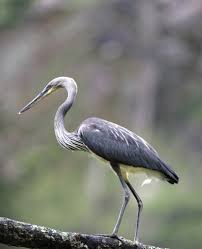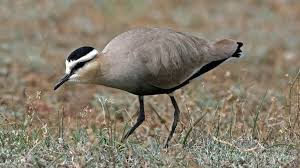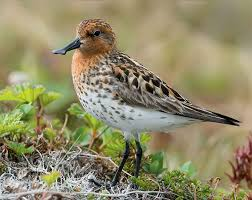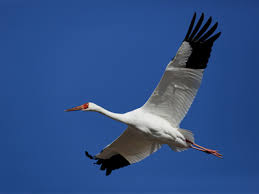1.The Jerdon’s Courser (Rhinoptilus bitorquatus)

It is a nocturnal bird found only in the northern part of the state of Andhra Pradesh in peninsularIndia. It is a flagship species for the extremely threatened scrub jungle. The species was considered to be extinct until it was rediscovered in 1986 and the area of rediscovery was subsequently declared as the Sri Lankamaleswara Wildlife Sanctuary.
Habitat: Undisturbed scrub jungle with open areas.
Distribution: Jerdon’s Courser is endemic to Andhra Pradesh. However, 19th century records do attribute its presence in the neighbouring areas of the state of Maharashtra.
Threats: Clearing of scrub jungle, creation of new pastures, growing of dry land crops, plantationsof exotic trees, quarrying and the construction of the Telugu-Ganga Canal. Illegal trapping of birds is also a threat.
2.The Forest Owlet (Heteroglaux blewitti)

It had been lost for more than a century. It has an interesting history. When not sighted for decades, posters were printed and Salim Ali, the premier ornithologist of India made a public appeal to look for the bird. After 113 long years, the owlet was rediscovered in 1997 and reappeared on the list of Indian birds.
Habitat: Dry deciduous forest.
Distribution: South Madhya Pradesh, in north-west Maharashtra and north-central Maharashtra.
Threats: Logging operations, burning and cutting of trees damage roosting and nesting trees of the Forest Owlet
3.The White-bellied Heron (Ardea insignis)

It is an extremely rare bird found in five or six sites in Assam and Arunachal Pradesh, one or two sites in Bhutan, and a few in Myanmar. It is inherently rare, and populations have never been known to be very high.
Habitat: Rivers with sand or gravel bars or inland lakes.
Distribution: Bhutan and north-east India to the hills of Bangladesh and north Myanmar.
Threats: Loss and degradation of lowland forests and wetlands through direct exploitation and disturbance by humans.
4 Vultures

Out of nine species of vultures, the population of three species-
White-backed Vulture (Gyps bengalensis), Slender-billed Vulture (Gyps tenuirostris) and Long-billed Vulture (Gyps indicus) has declined by 99%.
The Red- headed Vulture (Sarcogyps calvus) has also suffered a rapid decline in the recent past. Vultures keep the environment clean, by scavenging on animal carcasses. The decline in vulture populations has associated disease risks, including increased risk of spread of rabies and anthrax, besides adversely impacting the observance of last rites by the Parsis in the Towers of Silence.
Habitat: Forests, villages etc.
Distribution: Across India.
Threats: A major threat to vultures is the painkiller diclofenac used by veterinarians to treat cattle. When vultures consume these carcasses, diclofenac enters their system, but they are unable to metabolize it. Accumulation of diclofenac results in gout-like symptoms such as neck-drooping, ultimately leading to death.
5.The Bengal Florican (Houbaropsis bengalensis)

It is a rare bustard species that is very well known for its mating dance. Among the tall grasslands, secretive males advertise their territories by springing from the ground and flitting to and fro in the air.
Habitat: Grasslands occasionally interspersed with scrublands.
Distribution: Native to only 3 countries in the world – Cambodia, India and Nepal. In India, it occurs in 3 states, namely Uttar Pradesh, Assam and Arunachal Pradesh.
Threats: Ongoing conversion of the bird’s grassland habitat for various purposes including agriculture is mainly responsible for its population decline.
6. The Himalayan Quail (Ophrysia superciliosa)

It is presumed to be extinct since no reliable records of sightings of this species exist after 1876. Intensive surveys are required as this species is hard to detect due to its reluctance to fly and its preference for dense grass habitats. Possible sighting of this species was reported in Nainital in 2003.
Habitat: Tall grass and scrub on steep hillsides.
Distribution: Western Himalayas.
Threats: Indiscriminate hunting during the colonial period along with habitat modification.
7. Pink- headed Duck (Rhodonessa caryophyllacea)

It has not been conclusively recorded in India since 1949. Males have a deep pink head and neck from which the bird derives its name.
Habitat: Overgrown still-water pools, marshes and swamps in lowland forests and tall grasslands.
Distribution: Recorded in India, Bangladesh and Myanmar. Maximum records are from north-east India.
Threats: Wetland degradation and loss of habitat, along with hunting are the main causes of its decline.
8. The Sociable Lapwing (Vanellus gregarious)

It is a winter migrant to India. This species has suffered a sudden and rapid population decline due to which it has been listed as critically endangered.
Habitat: Fallow fields and scrub desert.
Distribution: Kazakhstan, Russia, Kyrgyzstan, Tajikistan, Uzbekistan, Turkmenistan, Afghanistan, Armenia, Georgia, Azerbaijan, Iran, Iraq, Saudi Arabia, Syria, Turkey, Egypt, India, Pakistan and Oman. In India, distribution is restricted to the north and north-west of the country.
Threats: Conversion of habitat to arable land, illegal hunting and proximity to human settlements.
9. The Spoon Billed Sandpiper (Eurynorhynchus pygmeus)

It requires highly specialized breeding habitat, a constraint that has always kept its population scarce. India is home to some of the last existing wintering grounds of this species (estimated at only 150-320 breeding pairs worldwide).
Habitat: Coastal areas with sparse vegetation. No breeding records further inland than 7 km from the seashore.
Distribution: Has been recorded in West Bengal, Orissa, Kerala and Tamil Nadu.
Threats: Habitat degradation and land reclamation. Human disturbance also leads to high incidence of nest desertion.
10.The Siberian Crane (Grus leucogeranus)

It is a large, strikingly majestic migratory bird that breeds and winters in wetlands. They are known to winter at Keoladeo National Park, Rajasthan.
Habitat: Wetland areas.
Distribution: Keoladeo National Park in Rajasthan.
Threats: Pesticide pollution, wetland drainage, development of prime habitat into agricultural fields, and to some extent, hunting.



